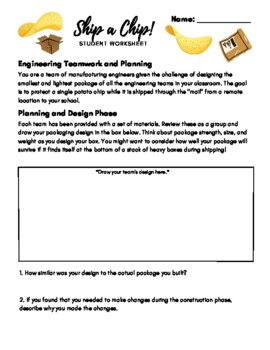STEM Ship a Chip!
Forever Curious
10 Followers
Grade Levels
2nd - 8th, Homeschool
Subjects
Resource Type
Standards
CCSS2.MD.A.1
CCSS2.MD.A.4
CCSS3.MD.A.2
CCSS5.MD.C.3
CCSS5.MD.C.3a
Formats Included
- PDF
Pages
4 pages
Forever Curious
10 Followers
Description
This is a STEM oriented activity called Ship a Chip where students get to be engineers and think about product design, packaging design, and customer support. This activity can be extended or reduced based on time and group needs. Typically it takes around 2 class periods for 2nd-5th grades but would also be great for older grades.
This has a short teacher guide and also a double sided student worksheet. With older students I like to add in more math but with younger grades we focus on the measurements of volume and weight. We also discuss the various steps in the postal service.
When measuring we found cubic centimeters for volume using a ruler and kilograms for mass using a digital scale.
Total Pages
4 pages
Answer Key
Does not apply
Teaching Duration
90 minutes
Report this resource to TPT
Reported resources will be reviewed by our team. Report this resource to let us know if this resource violates TPT’s content guidelines.
Standards
to see state-specific standards (only available in the US).
CCSS2.MD.A.1
Measure the length of an object by selecting and using appropriate tools such as rulers, yardsticks, meter sticks, and measuring tapes.
CCSS2.MD.A.4
Measure to determine how much longer one object is than another, expressing the length difference in terms of a standard length unit.
CCSS3.MD.A.2
Measure and estimate liquid volumes and masses of objects using standard units of grams (g), kilograms (kg), and liters (l). Add, subtract, multiply, or divide to solve one-step word problems involving masses or volumes that are given in the same units, e.g., by using drawings (such as a beaker with a measurement scale) to represent the problem.
CCSS5.MD.C.3
Recognize volume as an attribute of solid figures and understand concepts of volume measurement.
CCSS5.MD.C.3a
A cube with side length 1 unit, called a “unit cube,” is said to have “one cubic unit” of volume, and can be used to measure volume.



